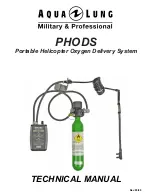
CS650 and CS655 Water Content Reflectometers
24
Required equipment:
•
CS650 connected to datalogger programmed to measure permittivity
•
Cylindrical sampling devices to determine sample volume for bulk
density, such as copper tubing with diameter of
≥
1 inch and length at
about 2 inches.
•
Non-metal container such as a PVC pipe (20 cm diameter, 35 cm
length) with one end closed. The container should be large enough to
ensure that only soil is within 10 cm (4 in) of the CS650 rod surface.
•
Oven or microwave safe container of known weight
•
Scale to measure soil sample mass
•
Oven or microwave to dry samples
The calibration coefficients are derived from a curve fit of known water
content and sensor permittivity output. The number of data sets needed to
derive a calibration depends on the form of the calibration equation. At least
three data sets should be generated to determine whether the linear form is
valid. If a polynomial is to be used, four data sets determine whether the
function is a quadratic or third order polynomial. Accuracy requirements may
need additional data sets. Consider the expected range of soil water content and
include data sets from the highest and lowest expected water contents.
Calibration procedure:
1.
Use relatively dry soil (volumetric water content <10%), which ensures
that the soil is homogeneous around the sensor rods.
2.
Uniformly pack the non-metal container with soil. Compaction of the
calibration soil needs to have similar bulk density as the soil at the field
site. Follow this method to ensure the soil is compacted uniformly:
a.
Roughly separate the soil into three or more equal portions.
b.
Evenly place a loose soil layer in the bottom of the container.
c.
Tamp the soil to a level that is correct for the target bulk density. Dry
soil without compaction has a typical bulk density, 1.1 to 1.4 g cm
–3
.
This step is especially important when bulk density is greater than
1.55 g cm
–3
.
d.
Scarify (loosen) the top of the compacted layer.
e.
Repeat steps b through d for each of the remaining soil layers.
3.
Carefully insert CS650 rods through the soil surface until the rods are
completely surrounded by soil. Avoid moving the rods from side to side
because this can form air voids around the rods.
4.
Collect the sensor permittivity output and remove sensor.
















































